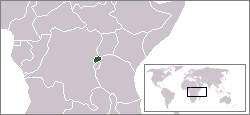Kingdom of Rwanda
| Kingdom of Rwanda | ||||||||||||
| Ubwami bw'u Rwanda (Kinyarwanda) Royaume du Rwanda (French) | ||||||||||||
| Independent state (11th century–1885) Part of German East Africa (1885–1916) Part of Ruanda-Urundi (1916–1962) | ||||||||||||
| ||||||||||||
| ||||||||||||
 | ||||||||||||
| Capital | Nyanza | |||||||||||
| Languages | Kinyarwanda, French, German (official from 1885-1916) | |||||||||||
| Government | Monarchy | |||||||||||
| Mwami | ||||||||||||
| • | 1081 – 1114 | Gihanga (1st Dyn.) (first) | ||||||||||
| • | 1959–1961 | Kigeli V (3rd Dyn.) (last) | ||||||||||
| History | ||||||||||||
| • | Autonomy from Belgium | July 25, 1959 | ||||||||||
| • | Republic declared | July 1, 1962 | ||||||||||
| ||||||||||||
Part of a series on the |
||||||||||||||||||
|---|---|---|---|---|---|---|---|---|---|---|---|---|---|---|---|---|---|---|
| History of Rwanda | ||||||||||||||||||
 | ||||||||||||||||||
|
||||||||||||||||||
|
| ||||||||||||||||||
The Kingdom of Rwanda was a pre-colonial kingdom in East Africa which survived with some of its autonomy intact under German and Belgian colonial rule until its monarchy was abolished in the Rwandan Revolution. After a 1961 referendum, Rwanda became a republic and received its independence in 1962.
Pre-colonization
In the 15th century, one chiefdom managed to incorporate several of its close neighbor territories establishing the Kingdom of Rwanda after disintegration of the Bunyoro-Kitara Empire(Bachwezi Empire), which ruled over most of what is now considered Rwanda, Burundi, Uganda,and parts of Tanzania. The Hutu majority, 82–85% of the population, were mostly peasants while the kings, known as Mwamis, were generally from Tutsi. Certainly some Hutus were nobility and, equally, considerable intermingling took place.
Before the 19th century, it was believed that the Tutsis held military leadership power while the Hutus possessed healing power and agricultural skills. In this capacity, the Mwami's council of advisors (abiiru) was exclusively Hutu and held significant sway. By the mid-18th century, however, the abiiru had become increasingly marginalized.
The position of Queen Mother was an important one, managing the royal household and being heavily involved in court politics.[1] When their sons ascended to the throne, mothers would take a new name. This would be composed of nyira-, meaning "mother of", followed by, usually, the regal name of the new king; only kings named Mutara do not follow this convention, their mothers taking the name Nyiramavugo (mother of good counsel).[2]
As the kings centralized their power and authority, they distributed land among individuals rather than allowing it to be passed down through lineage groups, of which many hereditary chiefs had been Hutu. Most of the chiefs appointed by the Mwamis were Tutsi. The redistribution of land, enacted between 1860 and 1895 by Kigeli IV Rwabugiri, resulted in an imposed patronage system, under which appointed Tutsi chiefs demanded manual labor in return for the right of Hutus to occupy their land. This system left Hutus in a serf-like status with Tutsi chiefs as their feudal masters.[3]
Under Mwami Rwabugiri, Rwanda became an expansionist state. Rwabugiri did not bother to assess the ethnic identities of conquered peoples and simply labeled all of them “Hutu”. The title “Hutu”, therefore, came to be a trans-ethnic identity associated with subjugation. While further disenfranchising Hutus socially and politically, this helped to solidify the idea that “Hutu” and “Tutsi” were socioeconomic, not ethnic, distinctions. In fact, one could kwihutura, or “shed Hutuness”, by accumulating wealth and rising through the social hierarchy.
See also
References
- ↑ Gérard Prunier (1995). The Rwanda Crisis, 1959-1994. C. Hurst & Co. p. 24.
- ↑ Leon Delmas (1950). Généalogies de la noblesse (les Batutsi) du Ruanda (in French). Vicariat Apostolique du Ruanda Kabgayi. p. 54.
le nom dynastique de leur fils, comme: Nyira-Yuhi, la mère de Yuhi-Musinga, Nyira-Kigeri, la mère de Kigeri-Rwabugiri, etc . . . Les rois du nom de Mutara devaient être des rois pacifiques et sociologues ; il leur fallait des conseillers experts pour bien gérer les intérêts du royaume, et le premier conseiller choisi fut la mère du roi, d'où le nom de Nyiramavugo qui signifie : mère du bon conseil, du bon langage.
- ↑ Johan Pottier (2002). Re-imagining Rwanda (PDF). Cambridge University Press. p. 13.
.svg.png)
